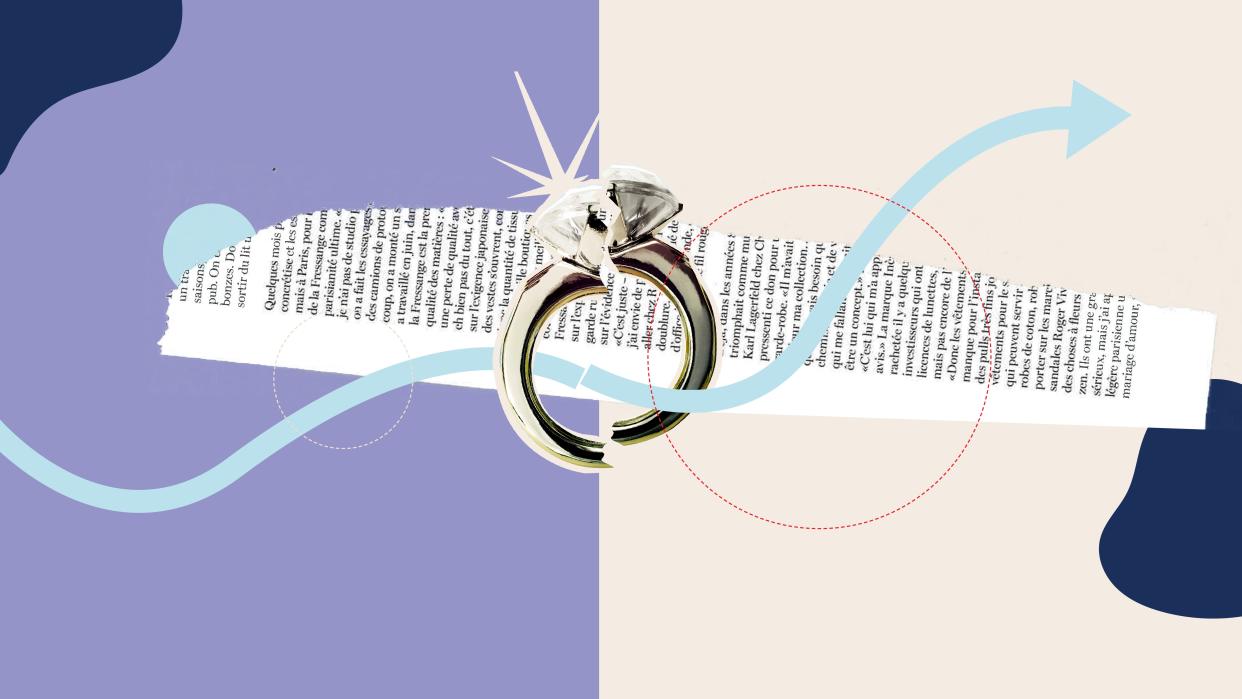In These Books, Happily Ever After Is Just the Beginning

Romance is a billion-dollar industry. In 2016 these novels made up 23% of the overall fiction market, and they consistently outperform all other genres. But while we’ve reclaimed the rom-com in film, these books are still often relegated to being “guilty pleasures,” or considered “mommy porn.” This week we’re discussing these overlooked, often powerfully feminist books—that just so happen to have a happy ending.
There are many hallmarks of a good romance novel. Meet-cutes, fiery chemistry, strong heroines, sex. But one thing that’s a must-have? Happy endings. It’s a genre mandate.
IRL, readers know that "happily ever after" doesn’t necessarily mean forever. But in books—from Jane Austen's to Nora Roberts's—the marriage plot has been part of the allure: picture-perfect ending, roll the credits, no fights over who does the dishes. Which is why it might come as a surprise that in the past few years there’s been a rise in romance novels that focus solely on couples in the post–"happily ever after" stage of their lives. A marriage or relationship is in trouble, leaving couples attempting to overcome these real-life issues and fall back in love.
Post-HEA is something New York Times best-selling author Colleen Hoover explored in her 2018 book All Your Perfects, which centers on a couple having fertility issues. Their struggle to conceive rocks their marriage and forces them to find their footing again. Hoover, who is also the author of the upcoming novel Regretting You, argues, "A person doesn’t need the perfect marriage or the perfect spouse or the perfect family to find fulfillment, and I think it’s important to portray that."
Readers agreed. "I’ve received many emails after writing All Your Perfects from readers who state the book helped them open up communication with their spouse, and even saved their marriage," says Hoover.
All Your Perfects isn’t the only recent romance to venture into less-than-perfect side of matrimony. More and more of these nuanced takes on relationship problems have begun to bubble up. Like The Bromance Book Club by Lyssa Kay Adams, You Deserve Each Other by Sarah Hogle, To Have and To Hoax by Martha Waters, and Grown-Up Pose by Sonya Lalli. (These themes are also touched upon in older works such as the Spiral of Bliss series by Nina Lane, Sherry Thomas’s Not Quite a Husband, and The Day of the Duchess by Sarah MacLean.)
In Grown-Up Pose, out March 2020, Lalli, who also wrote The Matchmaker’s List, doubles down on these issues by looking at it through the lens of a South Asian woman pressured by society to settle down—only to later realize that she’s not happy and wants a divorce.
"Every relationship, fictional or in the real world, is bound to have its ups and downs, and people overcome those obstacles or they can’t," Lalli says. "In Grown-Up Pose, I just chose to focus on an ebb in [Anu, the heroine’s] love story." Lalli stressed that people evolve as they grow up—especially when they’re in a relationship in their formative years, like Anu—and that inspired her to look at a couple growing apart, instead of growing up together, and how they can bridge the gap.
While these novels certainly present a truer-to-life take on relationships, they stand in stark contrast to the escapist, fantasy-style love stories readers have come to know and love. If romance novels are the professionally shot engagement photos you'd post on Instagram, these post-HEA books are the fight you get into months later while figuring out the seating chart at the reception. But for many, that's the exact point. They're real. And refreshing.
"I think seeing a marriage on the brink of divorce morph into a stronger-than-ever romance gives readers a new kind of hope that’s not about finding someone new, but rather strengthening a relationship they already have and value," says Kristine Swartz, editor at Penguin Random House’s Berkley imprint.
Schwartz worked with Adams on her debut, The Bromance Book Club, in which baseball player Gavin Scott and his wife, Thea, are going through a rough patch after three years of marriage and the birth of two kids. Gavin is desperate to get his family back together and reconnect with his wife, whom he’s never been able to make orgasm, he learns early on in the book. To better understand Thea—and their troubles in the bedroom—Gavin joins a secret fraternity: a romance book club for men. (And in life imitating art, Adams was contacted by a male reader who told her that he bought the book to read with his wife during a tough time in their marriage.)
Adams was inspired to reimagine "happily ever after" by looking at her own marriage. "I have been married for a while, so I know firsthand that the story doesn’t end at the proposal," she says. "And that it doesn’t end on your wedding day. [In a marriage] you have to get down to the hard work of actually earning your 'happily ever after.'"
"We’re taught how to fall in love [through entertainment], but we’re not often taught how to stay in love," Adams emphasized. "I do think one thing romance can do is really teach people how to [work on your relationship] or how to fall back in love with someone 5 years or 10 years after the wedding."
Kamrun Nesa is a freelance writer whose work has appeared on npr.org and the Washington Post. She's also the cohost of the romance podcast LITerally Us.
Originally Appeared on Glamour

